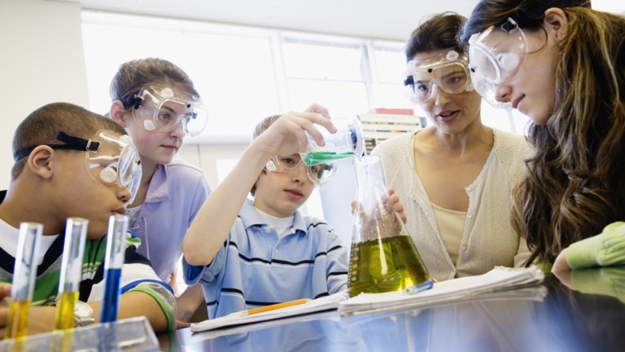For The Love Of Science

This article is supplied by Raytheon
The school year has begun, and Debra Palmer's fifth-grade class is learning the usual subjects. There's some math, some English – and of course, the kids will also design their own underwater robots.
Palmer, who works at Cesar Chavez Elementary School in Long Beach, California, is one of nearly 100 teachers nationwide to receive a Raytheon-Engineering is Elementary (EiE) Scholarship award, funded under a $2 million grant from Raytheon Company. Her $2,500 award covers training and classroom materials to help implement the EiE curriculum, which was developed by the Museum of Science in Boston.
Since winning the grant, Palmer has "been on Cloud Nine," she said. "I think it's great that engineering companies like Raytheon want to support teachers in expanding their horizons."
Palmer is beginning with EiE's "Designing Submersibles." It's a great follow-up to her school's involvement in a U.S. Navy program that gives students kits to build remote controlled underwater vehicles.
"EiE will be a great addition since it integrates the science concepts you need to engineer a submersible, like buoyancy," Palmer said.
The EiE program is designed to help teachers integrate science, technology, engineering and math – the subjects known collectively as STEM – into their daily curriculum. Teachers can apply online for the next round of Raytheon-EiE grants. Winners will travel to Boston for a professional development workshop, and will receive a full set of classroom materials.
More than half of Raytheon's 63,000 employees worldwide are engineers. The company's support for EiE goes beyond the financial. Company employees across the country make a practice of volunteering their own time and efforts to help promote STEM education.
Raytheon IT engineer George Ball is one of those employees. Last year, he spent Fridays attending a third grade class at John B. Wright Elementary School in Tucson, Arizona, helping the kids learn an EiE unit about water quality.
"The experience was very rewarding," Ball said. "The children were quite excited and enthusiastic, and looked forward to the Friday afternoons when the Raytheon participants would be in the classroom."
Hands-On Engineering
Angela Palo is a science specialist at the Horace Mann School for the Deaf and Hard of Hearing in Boston, which means she teaches students from kindergarten to the fifth grade. She won a Raytheon-EiE Teacher Scholarship grant last year, and is using it to add engineering to the Horace Mann curriculum.
A teacher at Horace Mann for eight years, and science specialist for four, Palo took an EiE training workshop in March, and ordered all 20 EiE teacher guides. She praises the care taken in the EiE program to make science concepts accessible for her students.
Take, for example, two EiE units; one on teaching about membranes, and one on building bridges.
"They struck me as very appropriate for my students. In the (membranes) storybook, the central character is from El Salvador, and in the bridges unit, the character has a blended family. Many of my students have similar life situations. So I thought these stories would appeal to them and help them put themselves in the picture, and think that they could be engineers, too."
Palo said she and her students have only just begun to use the EiE curriculum. The first project they did was building towers from index cards. "The students loved it. We displayed all the different tower designs for a week in the classroom. The students felt really proud."



